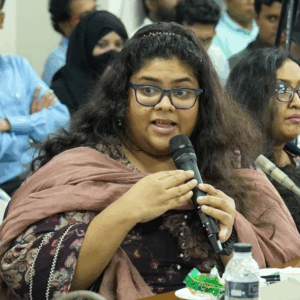Reimagined: Education Budget in Bangladesh
Dr. Rubaiya Murshed
Introduction
The persistent question that haunts educational discourse in Bangladesh is not merely one of quantity— how much education is provided— but of purpose: what it is for, and what outcomes it should achieve. As a homeless child once asked this author—then a university student at Dhaka University— “Why become educated? If it’s just about earning money, why not learn a trade and get a job?” This profound inquiry cuts to the core of Bangladesh’s educational priorities—and, more urgently, to how those priorities are reflected in our national education budget.
Bangladesh’s education budget has historically remained below international standards, never exceeding 2.13% of the country’s GDP against UNESCO’s recommended minimum of 4–6%. This chronic underinvestment reflects a fundamental misunderstanding of education’s multifaceted value and represents a critical failure to recognize the full spectrum of outcomes that education can and should produce. The time has come to reimagine Bangladesh’s approach to education budgeting—not merely as an increase in monetary allocation, but as a transformative restructuring that acknowledges education’s role beyond immediate economic returns.
The Current Paradigm: Labour Market Myopia
The dominant logic shaping education policy in Bangladesh is one of labour market myopia—a narrow focus on employment and economic advancement as the sole ends of education. This perspective is deeply ingrained, reflected in the oft-repeated Bengali saying: lekhapora kore jey, gari ghora chore shey (if you study, you’ll be rich enough to ride a car). This materialistic framing influences not just household aspirations but national budgetary decisions.
Education financing is currently shaped by this employment-centric narrative, with policy efforts directed largely toward expanding access and increasing the number of institutions. The rapid growth in Technical and Vocational Education and Training (TVET) institutions— from approximately 1,000 to over 4,000 within fourteen years (BANBEIS, 2023)— is a case in point. While skills development is critical, this expansion was driven by an unquestioned belief in the promise of skills as a quick-fix solution for employment, with little regard for broader human development goals (Murshed, 2024).
Likewise, the proliferation of universities—from 11 in 1990 to 158 in 2021—was premised on the assumption that expanding tertiary education would generate automatic growth. But this supply-side logic has contributed to graduate unemployment and credential inflation, without addressing the question of why and how education matters for adulthood beyond jobs (Ahmad & French, 2011; Islam, 2014).
Beyond Economic Outcomes: The Non-Labour Market Imperative
The reimagined education budget must acknowledge that education serves purposes far beyond immediate economic utility. The Ministry of Education’s National Education Policy 2010 itself recognizes this broader mandate, stating aims “to develop qualities of good citizens,” “to develop a democratic culture,” “to create in students a social awareness,” and “to stimulate intellectual and practical qualities so that moral, human, cultural, scientific and social values are established at personal and national levels” (Government of People’s Republic of Bangladesh, 2010, pp. 1–3).
These non-labour market outcomes—civic engagement, democratic participation, social awareness, and cultural values—represent what economists call the “wider benefits” of education. However, there exists a stark disconnect between these stated objectives and actual budget allocation. The current funding structure provides no meaningful resources for measuring, developing, or enhancing these outcomes, effectively treating them as afterthoughts rather than core educational objectives.
Research suggests that these non-labour market outcomes may be particularly crucial in Bangladesh’s context, where corruption, pollution, and violence remain persistent challenges. Education’s role in developing citizens who can contribute to justice, safety, and quality of life extends far beyond what monetary compensation alone can achieve. As McMahon (2009) argues, a sole focus on labour-market-oriented outcomes has led to the overlooking of non-labour market outcomes of education, hence leading to overall downplaying of education’s value and consequently to underinvestment in education. This argument is further supported by recent empirical work from rural Bangladesh, which finds that higher educational attainment significantly increases individuals’ likelihood of civic engagement—such as public speaking and community contributions—thereby strengthening the case for increased investment in education (Murshed & Sabates, 2025).
The Diversified Education Landscape: A Budget Challenge
Bangladesh’s education system consists of three major streams—general/academic, religious (madrasah), and TVET—each serving different social constituencies and embodying distinct objectives. Budgeting must be sensitive to this diversity.
The general stream has historically dominated policy discourse and resource allocation. In contrast, the madrasah stream—attended by 13.8% of primary and 21% of secondary students (World Faiths Development Dialogue, 2015)—aims not only to transmit religious knowledge but to foster moral character and community service. These schools emphasize values that are essential to non-labour market outcomes such as ethical reasoning, discipline, and communal belonging (Government of Bangladesh, 2010).
TVET, meanwhile, remains socially stigmatized, often perceived as a second-best option for students from disadvantaged backgrounds (Morris, 1996). Despite its promise for employability, TVET institutions suffer from uneven quality and disjointed integration with the rest of the education system.
A reimagined budget must not enforce uniformity across streams but instead invest in their distinct strengths. For madrasahs, this means recognizing their potential for nurturing non- economic outcomes. For TVET, it involves addressing stigma and ensuring quality. For all streams, it requires financial equity and curricular inclusivity.
Reimagining Resource Allocation: A Multidimensional Approach
The reimagined education budget must embrace a multidimensional approach that recognizes education’s diverse outcomes and allocates resources accordingly. This transformation requires several key shifts:
- Outcome-Based Budgeting: Rather than focusing solely on infrastructure and enrollment numbers, budget allocation should be tied to measurable outcomes across both labour market and non-labour market dimensions. This includes funding for civic engagement programs, democratic participation initiatives, and social awareness campaigns integrated into the educational
- Quality Over Quantity: The rapid expansion of educational institutions must be balanced with substantial investment in educational This means increased funding for teacher training, curriculum development, and learning resources that address the full spectrum of educational objectives.
- Equity Across Streams: The budget must ensure equitable resource distribution across general, madrasah, and TVET education streams while respecting their distinct missions and This includes addressing the urban-rural divide in TVET institution placement and supporting madrasah institutions in maintaining their unique educational contributions.
- Research and Evaluation: A significant portion of the budget should be allocated to research and evaluation mechanisms that can assess both labour market and non- labour market outcomes of education. This evidence-based approach will inform future policy decisions and ensure accountability in resource
The Economic Case for Non-Labour Market Investment
Ironically, what is often termed “non-economic” may yield the most profound economic dividends in the long run. A well-educated citizenry—ethically grounded, civically engaged, and socially responsible—forms the backbone of accountable governance and sustainable development (Sen, 1999).
Moreover, the current overemphasis on credential production has led to rising unemployment, social frustration, and loss of trust in the education system. By broadening the focus to include social, emotional, and civic competencies, Bangladesh may unlock deeper and more durable forms of national progress.
Conclusion: A Call for Transformation
The reimagining of Bangladesh’s education budget represents more than a fiscal exercise— it embodies a fundamental rethinking of education’s role in society. The current approach, with its exclusive focus on labour market outcomes and quantitative expansion, has failed to address the deeper purposes of education articulated in national policy documents and recognized by educational theorists worldwide.
The path forward requires courage to move beyond the comfortable certainties of economic reductionism toward a more nuanced understanding of human development. It demands recognition that the homeless child’s question—”Why become educated?”—deserves an answer that encompasses not just economic opportunity but the full range of human flourishing.
As Amartya Sen observed, “Education makes human-beings more articulate. It transforms people. You can think differently about the world.” This transformation extends far beyond the workplace into the realm of citizenship, community, and human dignity. Bangladesh’s education budget must reflect this broader vision, supporting not just workers and jobseekers but thoughtful citizens capable of building a more just and equitable society.
The reimagined education budget for Bangladesh must therefore be both ambitious and holistic, recognizing that true educational success cannot be measured solely in employment statistics or GDP growth, but in the cultivation of human beings capable of contributing to all dimensions of social progress. Only through such a fundamental shift can Bangladesh’s education system fulfill its true potential and justify the investment of public resources in human development.
References
Ahmad, N., & French, J. J. (2011). Decomposing the relationship between human capital and GDP: an empirical analysis of Bangladesh. The Journal of Developing Areas, 44(2), 127–142.
BANBEIS. (2023). Bangladesh Education Statistics 2022. Bangladesh Bureau of Educational Information and Statistics, Ministry of Education, Government of the People’s Republic of Bangladesh.
Government of the People’s Republic of Bangladesh. (2010). National Education Policy 2010. Ministry of Education.
Islam, R. (2014). Human Capital and Inclusive Growth: The Challenges for Bangladesh. First BEF Conference on Vision. First BEF Conference on Vision.
McMahon, W. W. (2009). Higher Learning, Greater Good: The Private and Social Benefits of Higher Education. Johns Hopkins University Press.
Morris, P. (1996). Asia’s Four Little Tigers: A Comparison of the Role of Education in Their
Development. Comparative Education, 32(1), 95–109.
Murshed, R. (2024). Labour Market and Non-labour Market Outcomes of Education in Bangladesh: Does Education Matter in the Formation of Outcomes in Adulthood? PhD thesis, University of Cambridge.
Murshed, R., & Sabates, R. (2025). Are educated individuals more likely to be civically engaged? Evidence from rural Bangladesh. International Journal of Educational Research, 131, 102574. https://doi.org/10.1016/j.ijer.2024.102574
Sen, A. (1999). Development as Freedom. Oxford University Press.
World Faiths Development Dialogue and Georgetown University’s Berkley Centre for Religion, Peace, and World Affairs. (2015). Faith and Development in Focus: Bangladesh. World Faiths Development Dialogue and Georgetown University’s Berkley Centre for Religion, Peace, and World Affairs.
Author’s Biography:



 Dr. Rubaiya Murshed is an Education Economist and Assistant Professor in the Department of Economics at the University of Dhaka. She holds a PhD from the University of Cambridge. She is the author of Nobody’s Children, published by the University Press Limited (UPL). Email:
Dr. Rubaiya Murshed is an Education Economist and Assistant Professor in the Department of Economics at the University of Dhaka. She holds a PhD from the University of Cambridge. She is the author of Nobody’s Children, published by the University Press Limited (UPL). Email: